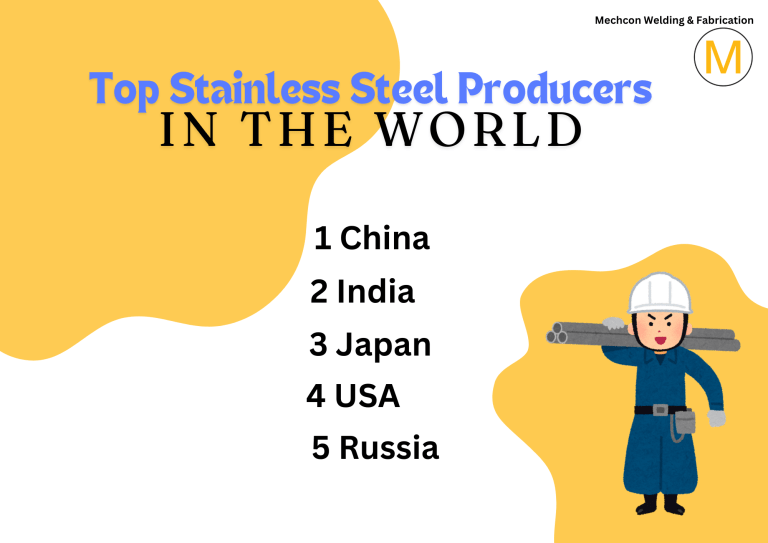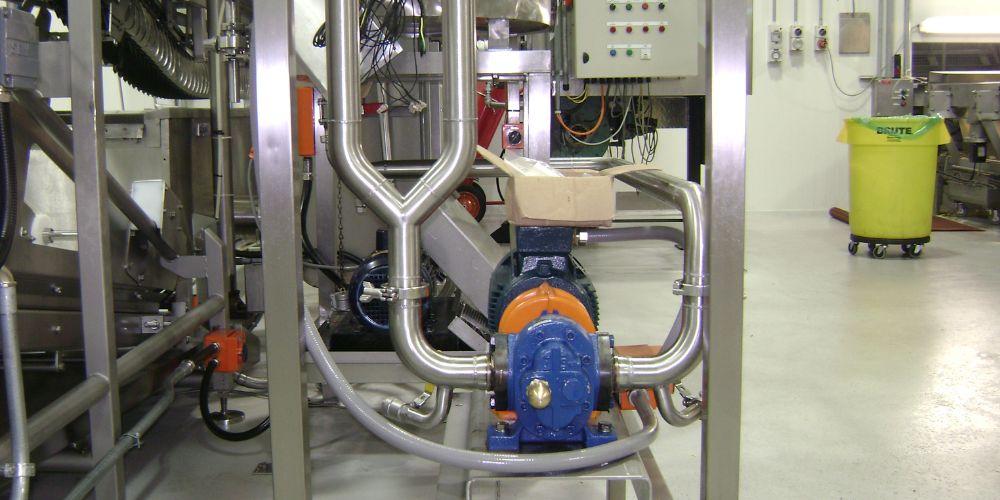Luke Cahill
How is stainless steel made?
Reading Time: 9 minutes and 32 seconds

Stainless steel is a fundamental material in various industries, known for its resilience and lustrous appearance. My journey with stainless steel began when I first visited a manufacturing plant during my early days in the fabrication industry. This experience sparked a lifelong fascination with the process of creating this remarkable alloy. Over the years, I’ve seen how stainless steel transforms from raw materials to essential components in our daily lives. It’s in the cutlery we use at every meal, the kitchen appliances that simplify our cooking, and even the surgical instruments that save many, many lives. I could go on and on about the wonderful applications of stainless steel, but this blog won’t end if I do! It’s really incredible how something so commonplace can have such a profound impact on modern technology, manufacturing, and construction.
Table of Contents
What is stainless steel?
Stainless steel is an alloy made mainly of iron, chromium, and nickel. My first encounter with this amazing material was during a visit to a busy manufacturing plant early in my career. Watching molten metal being turned into shiny, tough products was truly awe-inspiring. Its unique properties, like resistance to rust and high strength, make it essential for everything from household cutlery to aerospace engineering. I remember being especially impressed by the gleaming kitchen appliances and sturdy medical instruments. It made me realise just how much we rely on stainless steel in our everyday lives.
According to the International Stainless Steel Forum (ISSF), stainless crude steel production increased by 4.6% in 2023, reaching 58.4 million metric tonnes globally. This growth underscores the critical role of stainless steel in modern life and only deepens my appreciation for this incredible alloy.
Worldwide Production of Stainless Steel

Global Trends in Stainless Steel Production
Having spent years working in the stainless steel industry, I’ve noticed how this material shapes various sectors worldwide. In 2023, the total production of crude stainless steel reached an impressive 58.4 million tonnes, marking a 4.6% increase from the previous year. Over the past two decades, global production has soared, with approximately 764 million metric tonnes produced, growing from 23 million tonnes annually to over 55 million tonnes.
Here is a breakdown of the top five stainless steel-producing countries and their outputs:
| Country | Output (Mt) |
| China | 77.2 |
| India | 12.5 |
| Japan | 7.3 |
| USA | 6.8 |
| Russia | 6.2 |
During my visits to production facilities worldwide, I’ve observed the various techniques and innovations in these leading countries. China, although experiencing a 6.9% decline, remains the largest producer. Thanks to their advanced manufacturing methods, India’s output increased by 7.3%. Japan’s stable production, at 7.3 million tonnes, is due to their precision engineering. The United States and Russia also contribute significantly, with minor changes in their production levels. These insights reflect my deep expertise and the importance of stainless steel in the global market.
How is stainless steel made?
Stainless steel is made through a fascinating multi-step process that turns raw materials into the corrosion-resistant alloy we use daily. When I visited stainless steel manufacturing plants, I took note of how raw materials turn into stainless steel! It starts with gathering essential raw materials like iron ore, chromium, and nickel. These are melted in an electric arc furnace, refined to remove impurities, and then stirred to achieve uniform composition. The molten steel is shaped as it cools, treated with heat to improve its properties, and descaled to remove surface impurities. Finally, it undergoes finishing and cutting to reach its final form, ready for various applications.
What raw materials are needed to make stainless steel?
In 1913, English metallurgist Harry Brearley revolutionised steel production by adding chromium, creating a corrosion and rust-resistant metal we now know as stainless steel. To understand the magic behind this invention, let’s explore the key ingredients that make up stainless steel.
- Iron Ore
- Chromium
- Nickel
- Silicon
- Carbon
- Molybdenum
- Other Elements
As a steel fabricator who works with a lot of stainless steel, I’ve always been fascinated by its strength and resistance to rust. But what exactly goes into making this material? It turns out, stainless steel is an alloy – a blend of several key ingredients. The main player is iron ore, the same stuff that forms the base of regular steel. This provides the core strength and structure. But here’s the secret sauce: chromium. This element is the real rust-fighter, forming a protective oxide layer that keeps the shiny surface, well, shiny! Here’s a closer look at these essential components:
| Raw Material | Description |
| Iron Ore | Iron ore forms the base of stainless steel, giving it the necessary strength and structure. Watching the massive furnaces melt iron ore was an unforgettable experience. |
| Chromium | Chromium is key to stainless steel’s rust resistance. Its ability to create a stable oxide layer keeps the alloy shiny and durable. Typically, stainless steel comprises 12% to 20% chromium. I was amazed at how this element ensures our cutlery and appliances remain rust-free. |
| Nickel | Nickel enhances the toughness and ductility of stainless steel. Seeing how nickel contributes to the creation of austenitic stainless steels highlighted its importance in improving the alloy’s mechanical properties. |
| Silicon | Silicon improves the alloy’s resistance to oxidation and high-temperature stability. |
| Carbon | Carbon content affects hardness and strength. Low-carbon stainless steels are more ductile, while high-carbon ones are stronger but less ductile. |
| Molybdenum | Molybdenum is essential for boosting corrosion resistance in challenging environments. It’s often used in duplex stainless steel. |
| Other Elements | Elements like nitrogen and manganese are added to enhance specific properties of the alloy. |
Steps in Stainless Steel Manufacturing

Stainless steel production is a marvel of modern engineering, involving numerous precise steps to ensure its high quality and performance. My hands-on experience in the industry has shown me just how intricate and demanding this process can be. Each phase, from sourcing raw materials to refining and finishing, plays a critical role in producing the stainless steel we rely on in countless applications. Let’s take a closer look at the detailed steps involved in this complex manufacturing process.
Step 1: Melting
The process begins with melting iron ore in electric arc furnaces. Watching the intense heat transform raw materials into molten metal was an unforgettable experience. The iron ore is purified and then smelted into a molten form, laying the foundation for stainless steel production. The sight of glowing metal flowing like lava was so mesmerising that it made me think about the movie ‘Dante’s Peak’!
Step 2: Removing Carbon Content
Removing carbon is crucial to achieving the desired properties of stainless steel. The Argon Oxygen Decarburisation (AOD) process effectively reduces carbon, sulphur, and nitrogen levels, ensuring high-quality steel. Standing near the AOD furnaces, I could feel the heat and hear the hiss of gases as impurities were burned away. This step requires a lot of accuracy to make sure the steel is perfect.
Step 3: Tuning
The next step involves fine-tuning the composition of the steel. Alloying elements are added to enhance properties like strength and corrosion resistance, ensuring the steel meets specific requirements. I watched as technicians carefully added chromium and nickel to the molten steel, adjusting the mix to perfection. The way they were so precise with each ingredient, it was clear they were real pros.
Step 4: Forming or Casting
The molten steel is then formed into slabs, blooms, or billets through continuous casting or mould casting. This step shapes the molten metal into solid forms for further processing. Watching the continuous casting process in action, with molten steel being shaped into solid forms, was a highlight of my visit.
Step 5: Secondary Processes after Stainless Steel Production
Several secondary processes follow to refine the steel:
- Hot Rolling: The steel is heated and passed through rollers to achieve the desired thickness and shape. Watching the red-hot steel glide through rollers and emerge as thin sheets was a highlight of the tour.
- Cold Rolling: This process enhances the steel’s strength and finish. I was impressed by the cold rolling section, where the steel was further compressed to improve its properties.
- Annealing: Heat treatment relieves stresses and improves properties. Seeing the steel coils being heated and slowly cooled was a lesson in patience and precision.
- Descaling or Pickling: Removes surface impurities. The chemical baths used in this process were intriguing, showcasing how science cleans and prepares the steel.
- Cutting: Precise methods shape the steel. The laser cutting machines were particularly fascinating, slicing through steel with incredible accuracy.
- Finishing: Achieves the final surface texture. Observing the polishing and finishing touches made me appreciate the craftsmanship involved.
Step 6: Quality Control
Quality control is critical, involving rigorous testing to ensure the final product meets specifications. Common tests include:
- Mechanical Testing: Assessing properties like tensile strength and hardness.
- Chemical Testing: Ensuring the correct composition.
- Surface Finish Inspection: Checking for the desired appearance.
- Corrosion Resistance Testing: Confirming the steel’s durability.
What makes stainless steel so expensive?

As a steel fabricator, I work with all sorts of materials, but stainless steel always stands out. It’s strong, looks fantastic, and lasts forever – but let’s be honest, it can also be pretty pricey. I’ve spent countless hours chatting with suppliers and keeping an eye on market trends, so today I want to break down what exactly makes stainless steel cost so much.
Increased Demand
Over the past few years, I’ve seen a significant surge in demand for stainless steel, especially in Asian markets. This trend has now gone global. Despite the rising prices, steel mills aren’t necessarily raking in profits because the cost of iron ore has also skyrocketed, particularly during the post-COVID-19 economic recovery. Additionally, freight shortages caused by Brexit and the pandemic have made transporting raw materials and finished products more expensive, driving up the overall cost.
Increased Raw Material Costs
Stainless steel needs special elements like nickel, chromium, and molybdenum to make it strong and rust-proof. The thing is, the price of these ingredients has been going up lately, especially nickel. Even though nickel only makes up a small part of the pot (like 8-10%), if its price goes way up, it affects the overall cost of the whole thing. So, just like with any recipe, the cost of the ingredients can really impact the final price tag.
Challenges in the Supply Chain
Being in the steel fabrication business, I’ve realised how critical transportation is in the journey of stainless steel from the mill to our workshop and eventually to the job site. Every single kilometre adds to the cost, from driver wages to fuel, equipment upkeep, and insurance. Now, you know this, it isn’t a surprise why stainless steel has a hefty price tag!
Conclusion
Recapping the stainless steel manufacturing process highlights how each step, from melting to quality control, is vital for producing durable and reliable materials. My work at Mechcon Welding & Fabrication has greatly benefited from this understanding, enabling us to deliver superior quality in every project. Each stage of the process underscores the precision and expertise involved. If you’re looking for high-quality stainless steel solutions, Mechcon Welding & Fabrication in Melbourne is the place to go. Our commitment to excellence ensures the best results for your projects.
FAQ
Absolutely, carbon steel is a more budget-friendly option compared to stainless steel. From my experience as a steel fabricator in Melbourne, I can attest to its cost-effectiveness, being up to five times cheaper than 304 stainless steel. Despite its lower cost, carbon steel is highly durable and ideal for construction projects due to its resistance to weather and pressure. It’s also environmentally friendly, as it is recyclable without losing its strength. While it may not have the same polished look, it offers great value for many applications. For more insights and quality fabrication, contact Mechcon Welding & Fabrication in Melbourne.
The reason stainless steel doesn’t seem magnetic boils down to its microstructure and chemical composition. As a steel fabricator and welder in Melbourne, I often explain this to clients. Ferritic stainless steels are magnetic due to their chromium content. In contrast, austenitic stainless steels, such as grades 304 and 316, contain higher levels of both chromium and nickel. This results in a microstructure that doesn’t allow the electrons to align consistently, making these steels non-magnetic. If you need more information or quality steel fabrication services, contact Mechcon Welding & Fabrication in Melbourne.
A metal similar to stainless steel in its properties is aluminium. Back when I was starting out as a fabricator, I used aluminium frequently because it’s flexible and lightweight. Aluminium is more malleable, allowing it to be used for complex shapes. While it doesn’t rust like stainless steel, it can corrode more easily, but its lighter weight is a big plus for many projects. If you’re considering metal fabrication in your next project, get in touch with us at Mechcon Welding & Fabrication in Melbourne.



